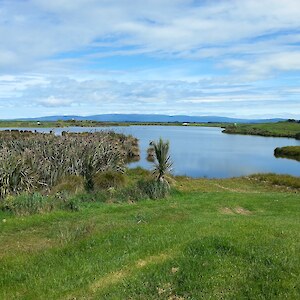SERN 2016 Spring Field Day
The sun shone on SERN’s field trip this weekend when nearly 30 people attended the trip to Long White Lagoon and Omaui.
Long White Lagoon is near the mouth of the Waimatuku River. It is in two parts, with the original eastern freshwater wetland having some Coprosma shrubland to the north and southwest. Fish and Game started restoration work in the 1980’s by blocking off drains to raise the water level on the western side to produce a series of ephemeral freshwater lakes which increased the habitat for water fowl. The shallow nature of the lakes makes them ideal for wading birds as well and they provide habitat for rare native herbs. The wetlands, protected by a QEII Open Space Covenant, were sold in the mid 1990’s to Peter McLeish.
Peter has been looking after the lagoon ever since he bought it and has carried out extensive planting on the western area and weed control. He has also fenced off the open water areas from stock, with a good margin of dryland where he has formed a vehicle/walkway access. Peter gets a lot of enjoyment out of the site and is keen to share this with others so visitors are welcome.
SERN enjoyed a walk around the northern edge of the lagoon to the Roger Sutton Lookout and contributed to the restoration of the site by planting some cabbage trees donated by the Waituna Landcare Group.
The second part of the day was a trip out to Omaui, where the Omaui Landcare Charitable Trust has been working to restore the native forest. Their work has focused on animal pest control and improving access with the development of a walking track. The pest numbers have significantly reduced since pest control began and although it is still early days Kakariki have moved in. The trust is now investigating the use of self re-setting traps so they can reduce their reliance on toxin based pest control.
At Omaui the field trip split into a long walk and a short walk. The long walk headed up the new track to the reserve boundary where the trust are hoping to install a viewing platform. This site has beautiful views out to Stewart Island and along the coast, but there is also views of the Omaui sand dunes which are home to Gunnera hamiltonii a nationally critical plant and Asaphodes frivola a rare and unusual moth species with flightless females.
Sharing ideas and experiences are one of the benefits of attending a field trip and this trip was full of discussion and the sharing of knowledge. In particular the first site visit and subsequent discussions has inspired Debbie Ellis at SIT to investigate the impact of mammalian pests on wetland environments. She hopes to use Long White Lagoon as a case study.
Both sites are great examples of what can be achieved by individuals and groups who take the initiative and work hard to protect their local environment.
Thanks to everyone who helped organise the trip.
Photos provided by Richard Bowman and Pat Hoffmann













